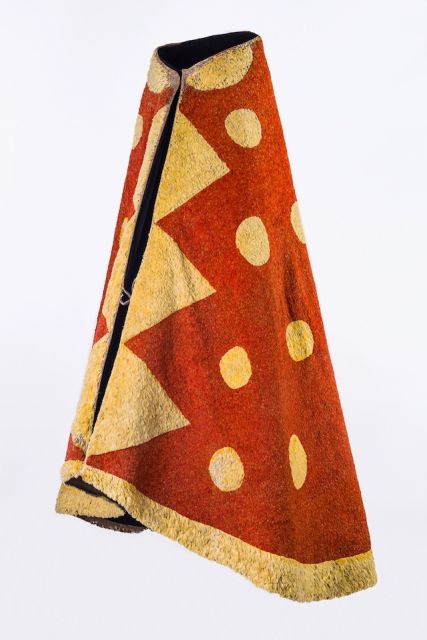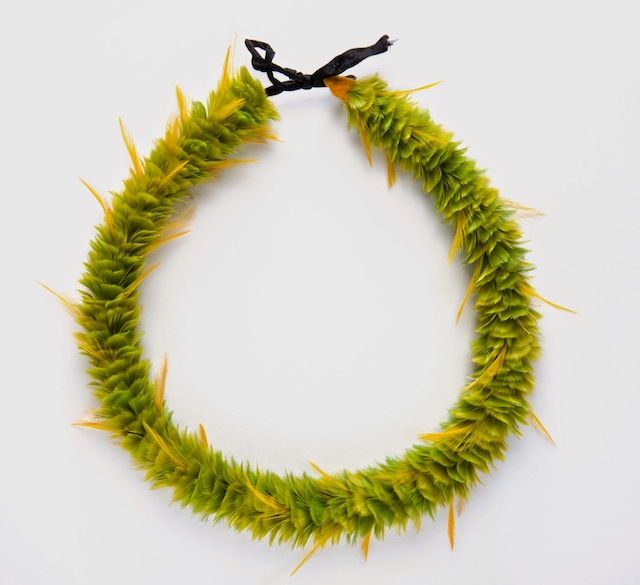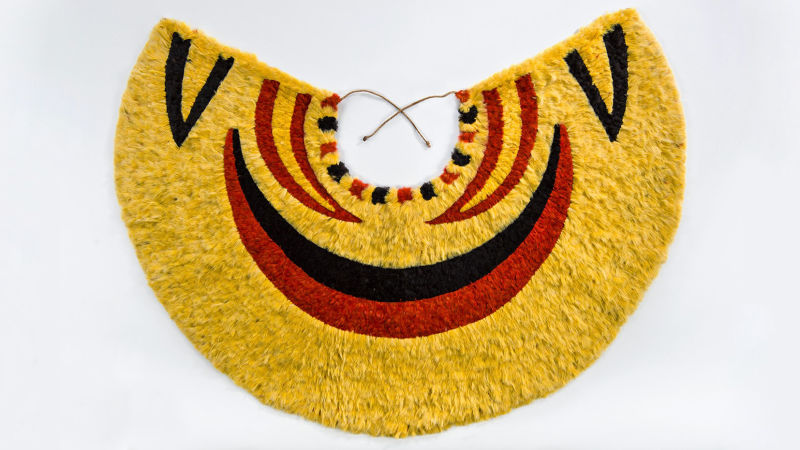Royal Hawaiian Featherwork: Nā Hulu Ali’i, on view at the de Young museum and on loan from the Bernice Pauahi Bishop Museum in Honolulu, is a gorgeous collection of 18th to early 20th century objects made for Hawaiian rulers. The approximately 75 pieces, including ‘ahu ‘ula (long cloaks and short capes), kāhili (royal staffs of feathers), lei hulu manu (feathered lei) and mahiole (helmets) once provided spiritual protection and indications of status. Today they give glimpses into the lives of royals during a turbulent era. The objects tell a story of a people impacted by everything from European explorers and Christian missionaries to annexation by the United States (and ensuing protests by Hawaiians).

Princess Ka’iulani of Waikiki wore a lei made of yellow ‘ō’ō feathers, red and green Kuhl’s lorikeet feathers and black ribbon on her 1893 journey to Washington, D.C., which she took to protest the overthrow of the Hawaiian monarchy. As a girl, Queen Emma wore a cape decorated with crescent shapes at the Chief’s Children’s School in Honolulu, run by two of the first missionaries to arrive on the islands. A large, bold cloak of ‘i’iwi feathers, ‘ō’ō feathers and olonā fiber was given to US Naval Officer Lawrence Kearny as a gift for protesting British Admiral Lord George Paulet’s claim of British sovereignty over Hawaii.
The ‘ahu ‘ula’s clean lines, thick stripes, and in one case, full circles, appear remarkably modern. Had I seen them out of context, I might think they were made two centuries later. Like avant-garde artist Sonia Delaunay‘s brilliant textiles, the capes feel like bright, rich fields one might melt into. These objects are, in certain senses of the word, delicious.
Feathers in mass quantity recall and simulate a range of substances, textures and environments. A large cloak made of brown pheasant feathers shimmers like a lake; an earthy red cloak appears softer, like powder; and one could mistake the white section of a hexagonal 18th-century cape for cotton.
Many of the lei, looped and tied with black silk ribbons, resemble large caterpillars. Laying flat below them, a 20th-century lei humupapa, made of blue Indian peafowl or green pheasant male feathers and dark blue woven wool fleece, appears reptilian. The flexible connotations of these solid, functional and spiritual garments make them transportive presences.

After spending several minutes looking closely at thousands of tiny, overlapping feathers, sensing the layers upon layers of concentration that built them, it is amazing to learn (thanks to a display of birds loaned from the California Academy of Sciences) that often, a single bird contributed only a few feathers to a piece. The now-extinct ‘ō’ō bird sported just two yellow feathers; its many remaining brown and black feathers went uncollected. The largest cloaks, made with up to half a million feathers, required an estimated 80,000 birds, and were constructed over the course of a generation.


